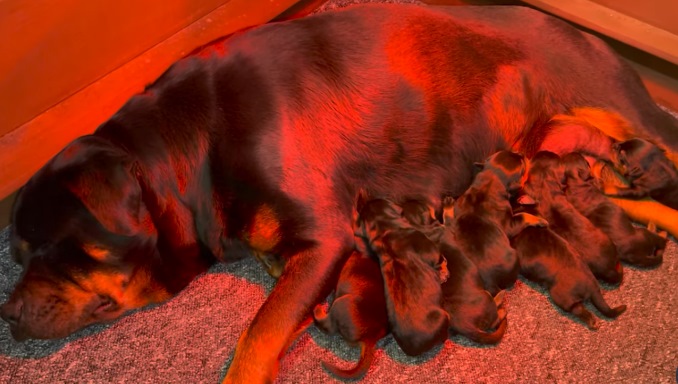How Many Pups Can A Dog Have?
Do you know How Many Pups Can A Dog Have? Hundreds of years ago, dogs were primarily used as working animals. They helped farmers and hunters with various tasks such as herding sheep and chasing down prey. But eventually, people began to see the companionship value in these animals and started to keep them as pets. And so began the era of dogdom as we know it today. Though there are no definitive answers, one question that often comes up is how many puppies a dog can have. Let’s explore this topic further.
How Many Pups Can A Dog Have?
How Many Pups Can A Dog Have? The answer to this question largely depends on the size of the dog. Smaller breeds typically have litters of two to four puppies, while larger breeds can have litters of up to 12 puppies. But there are always exceptions to the rule. For example, a Chihuahua might have as many as six puppies, while a Great Dane might only have two.
There are a number of factors that can affect how many puppies a dog has, including the dog’s age, health, and nutrition. Older dogs tend to have smaller litters than younger dogs, and dogs that are unhealthy or malnourished may also have smaller litters. In general, though, the size of the dog is the biggest determining factor in how many puppies it can have.
So, if you’re wondering how many puppies your dog could have, the answer is anywhere from two to 12 (or more). But ultimately, it all depends on the individual dog.
What’s the Largest Litter?
While there is no definitive answer to this question, the largest recorded litter was born to a Neapolitan Mastiff in 2004. The dog, named Tia, gave birth to 24 puppies (though only 21 of them survived). This event set a new Guinness World Record for the largest litter of puppies.
Tia’s story is certainly an extraordinary one, but it’s important to remember that she is not representative of all dogs. The vast majority of dogs will have much smaller litters, and even the largest breeds typically only have litters of up to 12 puppies. So while Tia’s story is amazing, it’s not something that you should expect from your own dog.

How Many Litters Can A Dog Have?
In addition to the question how many pups can a dog have, another question that people often ask is how many litters a dog can have in its lifetime. Again, there is no definitive answer to this question, as it depends on the individual dog. Some dogs may only have one or two litters in their lifetime, while others may have six or more.
There are a number of factors that can affect how many litters a dog has, including the dog’s age, health, and nutrition. Older dogs tend to have fewer litters than younger dogs, and dogs that are unhealthy or malnourished may also have fewer litters. In general, though, the size of the dog is the biggest determining factor in how many litters it can have.
So, if you’re wondering how many litters your dog could have, the answer is anywhere from one to six (or more). But ultimately, it all depends on the individual dog.
How Often Do Dogs Have Puppies?
The frequency with which dogs have puppies also varies depending on the individual dog. Some dogs may have a litter of puppies every year, while others may only have a litter every few years. There are a number of factors that can affect how often a dog has puppies, including the dog’s age, health, and nutrition. Older dogs tend to have fewer litters than younger dogs, and dogs that are unhealthy or malnourished may also have fewer litters. In general, though, the size of the dog is the biggest determining factor in how often it has puppies.
So, if you’re wondering how often your dog could have puppies, the answer is anywhere from once a year to once every few years (or more). But ultimately, it all depends on the individual dog.
How Many Puppies Can A Dog Have in a Lifetime?
In addition to the question how many pups can a dog have, you maybe want to know how many do dogs have in their life. There is no definitive answer to this question, as it depends on the individual dog. Some dogs may only have one or two litters in their lifetime, while others may have six or more. There are a number of factors that can affect how many litters a dog has, including the dog’s age, health, and nutrition. Older dogs tend to have fewer litters than younger dogs, and dogs that are unhealthy or malnourished may also have fewer litters. In general, though, the size of the dog is the biggest determining factor in how many litters it can have.
So, if you’re wondering how many litters your dog could have, the answer is anywhere from one to six (or more). But ultimately, it all depends on the individual dog.
How Many Puppies Can A Dog Have in a Year?
There is no definitive answer to this question, as it depends on the individual dog. Some dogs may have a litter of puppies every year, while others may only have a litter every few years. There are a number of factors that can affect how often a dog has puppies, including the dog’s age, health, and nutrition. Older dogs tend to have fewer litters than younger dogs, and dogs that are unhealthy or malnourished may also have fewer litters. In general, though, the size of the dog is the biggest determining factor in how often it has puppies.
So, if you’re wondering how many litters your dog could have in a year, the answer is anywhere from one to six (or more). But ultimately, it all depends on the individual dog.
When Do Dogs Have Puppies?
The answer to this question also depends on the individual dog. Some dogs may have their first litter of puppies at six months old, while others may not have their first litter until they are two years old. There are a number of factors that can affect when a dog has its first litter of puppies, including the dog’s age, health, and nutrition. Older dogs tend to have their first litter of puppies later than younger dogs, and dogs that are unhealthy or malnourished may also have their first litter of puppies later. In general, though, the size of the dog is the biggest determining factor in when it has its first litter of puppies.
So, if you’re wondering when your dog could have its first litter of puppies, the answer is anywhere from six months to two years (or more). But ultimately, it all depends on the individual dog.
How Long Does It Take For A Dog To Have Puppies?
The answer to this question also depends on the individual dog. Some dogs may have a litter of puppies in as little as six weeks, while others may take up to eight weeks. There are a number of factors that can affect how long it takes for a dog to have puppies, including the dog’s age, health, and nutrition. Older dogs tend to take longer to have puppies than younger dogs, and dogs that are unhealthy or malnourished may also take longer to have puppies. In general, though, the size of the dog is the biggest determining factor in how long it takes to have puppies.
So, if you’re wondering how long it could take for your dog to have puppies, the answer is anywhere from six weeks to eight weeks (or more). But ultimately, it all depends on the individual dog.

Answer the question “How Many Pups Can A Dog Have?” with some popular dog types
Labrador Retriever
Labrador Retrievers typically have six to eight puppies in a litter. However, some may have as many as twelve or more. The size of the litter depends on the size of the dog and the health of the mother. Labrador Retrievers are medium to large dogs, so they tend to have larger litters than smaller dogs.
Pregnancy period: 58-65 days
Number of pups per litter: 6-12, with an average of 8
Cane Corso
Cane Corsos typically have six to eight puppies in a litter. However, some may have as many as twelve or more. The size of the litter depends on the size of the dog and the health of the mother. Cane Corsos are large dogs, so they tend to have larger litters than smaller dogs.
Pregnancy period: 58-65 days
Number of pups per litter: 6-12, with an average of 8
French Bulldog
How many pups can a dog have with French Bulldog breed. French Bulldogs typically have four to six puppies in a litter. However, some may have as many as eight or more. The size of the litter depends on the size of the dog and the health of the mother. French Bulldogs are small to medium dogs, so they tend to have smaller litters than larger dogs.
Pregnancy period: 58-65 days
Number of pups per litter: 4-8, with an average of 6
Pomeranian
Pomeranians typically have two to four puppies in a litter. However, some may have as many as six or more. The size of the litter depends on the size of the dog and the health of the mother. Pomeranians are small dogs, so they tend to have smaller litters than larger dogs.
Pregnancy period: 58-65 days
Number of pups per litter: 2-4, with an average of 3
Pitbulls
Pitbulls typically have six to eight puppies in a litter. However, some may have as many as twelve or more. The size of the litter depends on the size of the dog and the health of the mother. Pitbulls are medium to large dogs, so they tend to have larger litters than smaller dogs.
Pregnancy period: 58-65 days
Number of pups per litter: 6-12, with an average of 8
Shih Tzu
How many pups can a dog have with Shih Tzu breed? Shih Tzus typically have two to four puppies in a litter. However, some may have as many as six or more. The size of the litter depends on the size of the dog and the health of the mother. Shih Tzus are small dogs, so they tend to have smaller litters than larger dogs.
Pregnancy period: 58-65 days
Number of pups per litter: 2-4, with an average of 3
German Shepherd Dog
German Shepherd Dogs typically have six to eight puppies in a litter. However, some may have as many as twelve or more. The size of the litter depends on the size of the dog and the health of the mother. German Shepherd Dogs are large dogs, so they tend to have larger litters than smaller dogs.
Pregnancy period: 58-65 days
Number of pups per litter: 6-12, with an average of 8
Boxer
Boxers typically have six to eight puppies in a litter. However, some may have as many as twelve or more. The size of the litter depends on the size of the dog and the health of the mother. Boxers are medium to large dogs, so they tend to have larger litters than smaller dogs.
Pregnancy period: 58-65 days
Number of pups per litter: 6-12, with an average of 8
Dalmatian
How many pups can a dog have with Dalmatian breed? Dalmatians typically have six to eight puppies in a litter. However, some may have as many as twelve or more. The size of the litter depends on the size of the dog and the health of the mother. Dalmatians are medium to large dogs, so they tend to have larger litters than smaller dogs.
Pregnancy period: 58-65 days
Number of pups per litter: 6-12, with an average of 8
Beagle
Beagles typically have six to eight puppies in a litter. However, some may have as many as twelve or more. The size of the litter depends on the size of the dog and the health of the mother. Beagles are medium to large dogs, so they tend to have larger litters than smaller dogs.
Pregnancy period: 58-65 days
Number of pups per litter: 6-12, with an average of 8
Golden Retriever
Golden Retrievers typically have six to eight puppies in a litter. However, some may have as many as twelve or more. The size of the litter depends on the size of the dog and the health of the mother. Golden Retrievers are large dogs, so they tend to have larger litters than smaller dogs.
Pregnancy period: 58-65 days
Number of pups per litter: 6-12, with an average of 8
German Shepherd
How many pups can a dog have with German Shepherd breed? German Shepherds typically have six to eight puppies in a litter. However, some may have as many as twelve or more. The size of the litter depends on the size of the dog and the health of the mother. German Shepherds are large dogs, so they tend to have larger litters than smaller dogs.
Pregnancy period: 58-65 days
Number of pups per litter: 6-12, with an average of 8
Bulldog
Bulldogs typically have four to six puppies in a litter. However, some may have as many as eight or more. The size of the litter depends on the size of the dog and the health of the mother. Bulldog are medium to large dogs, so they tend to have larger litters than smaller dogs.
Pregnancy period: 58-65 days
Number of pups per litter: 4-6, with an average of 5
Poodle
Poodles typically have four to six puppies in a litter. However, some may have as many as eight or more. The size of the litter depends on the size of the dog and the health of the mother. Poodles are medium to large dogs, so they tend to have larger litters than smaller dogs.
Pregnancy period: 58-65 days
Number of pups per litter: 4-6, with an average of 5
Husky
Huskies typically have six to eight puppies in a litter. However, some may have as many as twelve or more. The size of the litter depends on the size of the dog and the health of the mother. Huskies are large dogs, so they tend to have larger litters than smaller dogs.
Pregnancy period: 58-65 days
Number of pups per litter: 6-12, with an average of 8
Rottweiler
Rottweilers typically have six to eight puppies in a litter. However, some may have as many as twelve or more. The size of the litter depends on the size of the dog and the health of the mother. Rottweilers are large dogs, so they tend to have larger litters than smaller dogs.
Pregnancy period: 58-65 days
Number of pups per litter: 6-12, with an average of 8
German Shorthaired Pointer
German Shorthaired Pointers typically have six to eight puppies in a litter. However, some may have as many as twelve or more. The size of the litter depends on the size of the dog and the health of the mother. German Shorthaired Pointers are large dogs, so they tend to have larger litters than smaller dogs.
Pregnancy period: 58-65 days
Number of pups per litter: 6-12, with an average of 8
Dachshund
How many pups can a dog have with Dachshud breed? Dachshunds typically have four to six puppies in a litter. However, some may have as many as eight or more. The size of the litter depends on the size of the dog and the health of the mother. Dachshunds are medium to large dogs, so they tend to have larger litters than smaller dogs.
Pregnancy period: 58-65 days
Number of pups per litter: 4-6, with an average of 5

The First Sign of Dog Pregnancy
The first sign of dog pregnancy is the change of behavior in your dog. She will become more affectionate and loving. She will want to be close to you and will follow you everywhere. This is because she is trying to create a strong bond with you so that she can feel protected during her pregnancy.
Other behavioral changes may include nesting, where your dog will start to collect her toys and bedding in one spot, as well as becoming more protective of her food.
Changes in appetite are common in early pregnancy, with some dogs becoming ravenous while others lose their appetite altogether. If your dog experiences a sudden change in appetite, it’s best to speak to your vet to rule out any potential health problems.
Physical changes in early pregnancy may be difficult to spot. However, some dogs may start to produce milk or experience a change in color of their nipples (pinking up). You may also notice your dog’s abdomen appearing slightly larger or more bloated than usual.
If you think your dog might be pregnant, the best thing to do is make an appointment with your vet for a confirmed diagnosis. They will be able to advise you on the best course of action for the rest of your dog’s pregnancy.
Do dogs sense pregnancy?
In addition to the question how many pups can a dog have, people also asked do dogs sense prenancy. Many dog owners report that their dogs seemed to know they were pregnant even before they did. This is because dogs are incredibly intuitive and can pick up on changes in our behavior and scent.
If you think your dog may be picking up on your pregnancy, pay close attention to their behavior. Do they seem extra clingy or protective? Are they more interested in your belly than usual? These are all potential signs that your dog knows you are pregnant.
Of course, the only way to know for sure if your dog can sense your pregnancy is to ask them! Try asking your dog if they know you are going to have a baby. If they respond in any way, it’s a good sign that they are tuned into your pregnancy.
If my dog is tied is she pregnant?
If your dog is tied, it means she has been mated with a male dog and there is a chance she is pregnant. Dogs usually tie for about 15 minutes, during which time the male’s penis swells inside the female’s vagina. This helps to ensure that the sperm are released and can travel up to the eggs.
After tying, the male and female dogs will usually separate. However, some dogs may stay tied for longer periods of time. If you are concerned that your dog has been tied for too long, it’s best to speak to your vet for advice.
What Should I Do If My Dog Is Pregnant?
If you think your dog is pregnant, the first thing you should do is take her to the vet for confirmation and check-up. Your vet will be able to tell you how many puppies to expect and when your dog is due. They will also be able to give you information on how to care for your pregnant dog and what to expect during the pregnancy and delivery. If you have any questions or concerns, be sure to ask your vet so that you can be as prepared as possible for your dog’s upcoming litter.
Pregnant dogs need extra care and attention, so be sure to provide your dog with plenty of love and affection during this time. She may also need more food and exercise than usual, so be sure to consult with your vet on how to best care for your pregnant dog.
Some Tips for Caring for Your Pregnant Dog:
• Give your dog plenty of love and attention.
• Make sure she has access to fresh, clean water at all times.
• Provide her with plenty of food and exercise.
• Consult with your vet on how to best care for your pregnant dog.
• Be prepared for the delivery by having everything you need on hand, such as towels, scissors, and a clean area for the puppies to be born.
• After the puppies are born, make sure they have access to fresh, clean water and plenty of food.
• Consult with your vet if you have any questions or concerns about your pregnant dog or the delivery.
By following these tips, you can help ensure that your pregnant dog has a happy and healthy pregnancy.

Dog Pregnancy Week by Week
Dog 2 weeks pregnant
At two weeks pregnant, your dog’s eggs will have been fertilized by the sperm and will be making their way down the fallopian tubes to the uterus.
During this time, your dog’s body will be preparing for pregnancy by making changes to her hormone levels. This can cause some dogs to experience a change in appetite or an increase in thirst.
You may not be able to see any physical changes in your dog at this stage, but she may start to act differently. Some dogs become more clingy or protective during this time.
If you think your dog may be pregnant, it’s best to take her to the vet for confirmatio
Dog 3 weeks pregnant
At three weeks pregnant, your dog’s fertilized eggs will have reached the uterus and will be attaching themselves to the uterine wall.
During this time, your dog’s body will be continuing to make changes to her hormone levels in preparation for pregnancy. This can cause some dogs to experience a change in appetite or an increase in thirst.
You may not be able to see any physical changes in your dog at this stage, but she may start to act differently. Some dogs become more clingy or protective during this time.
Dog 4 weeks pregnant
At four weeks pregnant, your dog’s puppies will be growing and developing inside her uterus.
During this time, your dog’s body will be continuing to make changes to her hormone levels in preparation for pregnancy. This can cause some dogs to experience a change in appetite or an increase in thirst.
You may not be able to see any physical changes in your dog at this stage, but she may start to act differently. Some dogs become more clingy or protective during this time.
Dog 5 weeks pregnant
During weeks 5 and 6, the fetus starts to look more like a puppy, with toes, nails, and whiskers. The fetus’s organs have completely developed, along with its skin color. At the six-week mark, the fetus has sex organs and begins to develop into either a male or a female.
Dog 8 weeks pregnant
The process of giving birth is not an easy one for your pup. She’ll be producing milk and may seem restless or start digging in her whelping area, which can lead to nesting behaviors like pushing out the puppies with help from mommy dog’s Vaginal Cell Masses (VEMS).
A lot goes on behind the scenes during this magical moment; let’s take a look at what you need before things get started!

FAQs of how many pups can a dog have
How can I tell if my dog is pregnant?
If you think your dog might be pregnant, the best thing to do is make an appointment with your vet for a confirmed diagnosis.
Your vet will likely do a physical exam and may also recommend doing a blood test or ultrasound to confirm the pregnancy.
How long does a dog pregnancy last?
Dog pregnancies typically last about 63 days, but this can vary depending on the size of the litter and the breed of dog.
What should I feed my pregnant dog?
You should consult with your veterinarian to determine the best diet for your pregnant dog. They may recommend a special pregnancy formula food or additional supplements.
What are the signs of labor in dogs?
The signs of labor in dogs can vary, but some common signs include restless behavior, nesting, panting, and increased vocalization.
If you think your dog is in labor, it’s important to call your vet right away. They will be able to give you instructions on what to do and help you get your dog through the delivery safely.
How many pups can a dog have if they’re old?
The age of the dog can affect how many puppies it can have in a litter. Generally, older dogs are more likely to have smaller litters and even fewer puppies due to their age. A healthy, mature female dog that is between one and eight years old typically has an average litter size of four to six puppies. However, if the dog is over eight years old, the average litter size may decrease to two to four puppies. Some older dogs have even been known to only have one puppy in a litter. Therefore, it is important to consult with a veterinarian before attempting breeding an older dog. Additionally, the age and health of both parents can affect the number of puppies that will be in the litter.
Is 10 puppies a big litter?
The average litter size for dogs is six, but it can range from one to 16 puppies. Litters of 10 or more are considered large and may require special care during delivery and after birth.
If you have a large litter, be sure to consult with your veterinarian on the best way to care for your puppies. They may need to be delivered by C-section or require additional care after birth.
How many puppies can a dog have the first time?
Dogs can have anywhere from one to 16 puppies, but the average litter size is six. The number of puppies a dog has the first time they give birth is typically smaller than subsequent litters.
How do I take care of my newborn puppies?
Newborn puppies are very delicate and require special care. They should be kept warm and should not be allowed to nurse for the first few hours after birth.
You should also consult with your veterinarian on the best way to care for your newborn puppies. They will be able to give you specific instructions on what to do and how to keep them healthy.
Conclusion
As you can see, there is no one answer to the question of how many puppies a dog can have. Much depends on the size and breed of the dog, as well as the health and age of the mother. However, with responsible breeding practices, it is usually possible for a female dog to have six to eight puppies at a time. So if you’re thinking about getting a new puppy, be sure to do your research and find an animal that will fit into your lifestyle and home environment. And always remember to spay or neuter your pet – this is one of the best ways to help reduce overpopulation and keep dogs out of shelters.
Above is the article “How many pups can a dog have?”. Thanks for reading!








